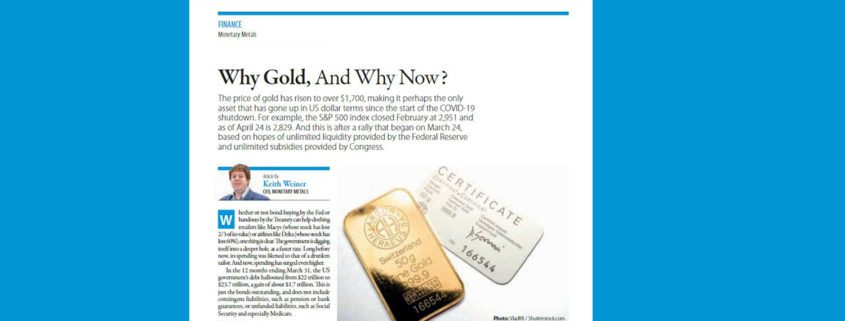Why Gold, And Why Now?
Last spring, CEO Keith Weiner appeared in Executive Global Magazine, with the article, Why Gold, And Why Now?
In it, he walks us through the growing US debt numbers and the dwindling yields of Treasury bonds – as well as their increasing risk. And explains gold as an investment. Now, four months later, it rings even more true.
Here’s the article in its entirety, published May 26th. Enjoy!
Why Gold, And Why Now?
Whether or not bond-buying by the Fed or handouts by the Treasury can help clothing retailers like Macys (whose stock has lost 2/3 of its value) or airlines like Delta (whose stock has lost 60%), one thing is clear. The government is digging itself into a deeper hole, at a faster rate. Long before now, its spending was likened to that of a drunken sailor. And now, spending has surged even higher.
In the 12 months ending March 31, the US goverment’s debt ballooned from $22 trillion to $23.7 trillion, a gain of about $1.7 trillion. This is just the bonds outstanding, and does not include contingent liabilities, such as pension or bank guarantees, or unfunded liabilities, such as Social Security and especially Medicare.
Ever Growing Debt
So $1.7 trillion is the baseline. President Trump signed the CARES Act into law on March 29, and the spending began to ramp in April. The Act authorizes $2.3 trillion worth of spending. In addition, on April 24, he signed a bill to add $0.5 trillion more for small businesses. This brings the total new spending in the wake of the virus so far to $2.8 trillion. There will almost certainly be more.
But it gets worse.
With 26 million people laid off, hundreds of thousands of businesses either bankrupted or hanging on by spending their accumulated capital, and countless people who now have much-reduced incomes, tax receipts will be lower. Let’s assume a decline by $1 trillion, to be conservative.
This brings the deficit tally to 1.7 + 2.3 + 0.5 +1.0 = $5.5 trillion. Not counting any additional spending, which is sure to come. The debt on April 1, 2021 will be over $29 trillion.
Do You Want To Be A Creditor To This Government?
The risk to lenders is mounting. Meanwhile, the compensation they are paid to assume this risk is dropping. About 18 months ago, In October 2018, the 10-year Treasury bond paid 3.2%. In January this year, it still paid 1.8%. However, by the second week of March, the yield had fallen to 0.5%. Whatever case there was to own Treasury bonds at 3.2% yield has all but evaporated now.
The case for buying gold is not really about exposure to gold’s price. It is about avoiding exposure to the government’s credit.
And while avoiding such exposure, Monetary Metals investors can earn 2% to 4.5% interest on their gold, paid in gold.




Leave a Reply
Want to join the discussion?Feel free to contribute!